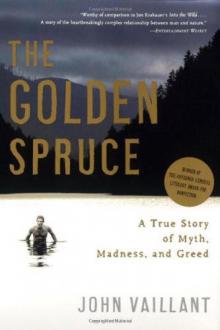- Home
- John Vaillant
The Golden Spruce Page 4
The Golden Spruce Read online
Page 4
It is always amazing to consider the things a man will risk his life for, and the promise of a case of beer on Friday could mean the difference between an average week of log production and a record-setting one; it could also mean the difference between life and death. But as the machines got bigger, more powerful, and more expensive to own and operate, the expectations only rose. Neil McKay remembers an enormous machine from the 1920s called the Washington Flyer; it was a steam donkey five metres long by three metres wide; it rode on a twenty-five-metre sled made from logs that were over a metre in diameter, and it could work over a kilometre of five-centimetre skyline cable. “It was a monstrous goddamn thing,” recalls McKay; “you could clear a whole mountainside with it.” And so they did, the gear running so hard that pulleys and cables sometimes glowed red hot and set fire to the surrounding woods.
Since the donkey puncher (the man operating the donkey) might be a kilometre or more away from the chokermen who were “setting” the chokers around the logs ready to be yarded (hauled) out of the bush, a code of whistles was used to communicate what was needed down the line: haul back; ease forward; stop, etc. There was even a special death signal: seven long blasts. The man in charge of passing this information back and forth was known as the whistlepunk and he would be stationed on a tree stump or some other piece of high ground where he could see the big picture. Below him, looking like so many squirrels in the face of these huge trees, mountains, and machines, the fallers and chokermen spent their often rainy days beset by swarms of mosquitoes and biting flies as they scrambled over giant logs, rocks, and the sharpened points of broken branches, struggling to meet or surpass their foreman’s quota. It was an environment that seemed scientifically designed to crush limbs and puncture bodies, and it is no wonder that men were frequently injured or killed, or that they often quit, or that they might eat three T-bone steaks, a plate full of potatoes, and a serving bowl full of ice cream for dinner. It was into this headlong and perilous netherworld that Grant Hadwin’s Uncle Angus descended while still a boy.
CHAPTER THREE
A Boardwalk to Mars
Next year we will practise havoc
in that green trench—
the saws will yammer their nagging dirge,
the donkeys will gather the corpses,
the land will be hammered to stumps and ruin
—Peter Trower, “The Ridge Trees”
ANGUS MONK WENT into the woods at the age of thirteen. This wasn’t so unusual in the 1920s when millions of boys, rendered fatherless by World War I, were forced by circumstances to leave home and make their way in the world. On the West Coast in those days, finding a boy as young as ten taking a shift at the wheel of a tugboat while the skipper slept, or paddling a dugout canoe to an island that might lie several kilometres offshore wasn’t out of the ordinary. It was a different time: the country was huge, the population small, and the workload enormous; competence—in any form—was exploited to its fullest extent. The Monk family had come to Canada from the tiny Scottish island of Benbecula in the Outer Hebrides; this barren, windswept archipelago is Europe’s answer to the Queen Charlottes—minus the trees. The rigours of life out there, at the mercy of the North Atlantic, necessitated a tough and fearless constitution, a characteristic that Angus embodied fully. Naturally drawn to outer limits, both physical and geographic, he made his way to Vancouver Island, where the logging camps served as his high school and university. Though barely pubescent when he started, Angus proved an apt, if restless, pupil. Drifting from camp to camp, he picked up a wide variety of skills, emerging as an exceptional high rigger, the most dangerous and highly paid job in the woods.
If you run across an old photo of a man with an axe perched high in a tree, you are not looking at a faller, you are looking at the far rarer high rigger. Like the steelworkers who build skyscrapers, these men were a breed apart; they were the ones who prepared the spar trees to run high-lead cable. A high rigger’s duties included hanging the huge pulleys—a metre across and nine hundred kilograms—that carried the cable, and setting the guy lines that anchored the spar tree from all sides in order to keep it from being pulled over by the tremendous loads it would be supporting. It was a job that required an unusual combination of raw courage, gymnastic strength, and technical skill; the success of a logging operation hung, literally, on the competence of its high rigger.
The first high riggers were sailors; already at ease at the tops of tossing masts and familiar with complex rigging, they were naturals for the job. A high rigger’s special equipment was minimal: eight-centimetre climbing spikes which were strapped to his ankles, and a heavy rope that was clipped to his waist and slung around the tree’s trunk. The rope was woven with a wire core in order to prevent it from being accidentally cut by the rigger’s axe—a shorter, more compact version of those used by fallers. Also attached to his belt, in addition to the axe and a one-man crosscut saw, would be a long “straw line” this light rope was used to haul up successively larger ropes, cables, and blocks (pulleys) once the spar had been made ready. Thus prepared, a high rigger like Angus Monk would “hug” his way up trees nearly eighty metres high, lopping branches as he went. Because the topmost portion of the tree was thinner and not as strong, it would be cut off; sometimes it was blown off with dynamite. Topping the spar was a tricky operation; if a breeze came up and the top began to fall before it had been cut through completely, the tree could “barber chair”—split open along its length—with the result being that the rigger would be crushed between the expanding tree and his fixed safety rope. For trees this tall to survive winter gales, they must be extremely flexible, so even when everything went according to plan, the release of the several-ton spar top would cause the tree to sway wildly. Co-workers on the ground would watch as the tiny rigger ducked his head, dug in his spikes, and held on for dear life while the spar thrashed back and forth like a ship’s mast in a storm. After all was calm again, some high riggers, including Angus, would stand on the platform they had made—about as wide as a cocktail tray—and urinate into space. Once all the blocks were in place, the rigger could then rappel down; Angus became so adept at high-speed descents that he could throw his hat in the air at fifty metres and be on the ground when it landed. For these reasons, among others, high riggers were viewed with a certain awe by other loggers—a combination of admiration and relief that the job wasn’t theirs. Once back on earth, such a man was entitled to a certain swagger; part stuntman, part matador, and absolutely indispensable, there was no doubt he was a card-carrying “cock of the woods.”
But even high riggers were employees, and Angus had higher aspirations. Eventually he learned enough on the job to go out on his own, becoming what was known in the industry as a gyppo logger; it was a big and precarious leap. Gyppos were independent operators who might own a few trucks, a couple of mobile camps, and the shows they ran tended to reflect their own characters, for better or worse. Like their agricultural equivalent, the freehold farmer with sixty cows and a quarter-mile section, they were extremely vulnerable to the whims of the marketplace, and they are an endangered species today. During the late fifties and sixties, Angus and his crew were clear-cutting the valleys above Howe Sound, a deep fjord that feeds into Vancouver’s English Bay from the north. Though often shrouded in clouds and fog, it is a stunning setting of deep shining water dotted with islands and overseen by mountains cloaked in forest. Winding through West Vancouver and up the sound’s east side is the Sea to Sky Highway; the road, which went through in 1958, was an engineering feat on a par with California’s Highway One. There is no other highway on the continent that places a traveller so tightly between the jaws of mountain and sea. Angus Monk had a contract to log the steep slopes above it.
VANCOUVER IN THE 1950S was still very much a British colonial town, and government, social mores, and education all reflected this. Cut off from the rest of Canada by the Rocky Mountains and the Coast Range, and from the United States by the border, Vancouver fl
oated in a lush green world all its own. To this day, the west side still has some of the feel of a British colonial suburb like those in Cape Town, Hong Kong, or Penang—only with English weather. When it isn’t raining, sailboats cruise the bay beneath snow-capped mountains while cricket, lawn bowling, and tennis are played at the clubs ashore. Fig trees, windmill palms, and Japanese bananas flourish alongside Chilean monkey puzzles and tree-sized camellias in a climate that feels closer to California than to Canada.
Vancouver’s east side was a separate world from the serene and stately west side suburbs. In the dense shingle and clapboard neighbourhoods that rose above the docks and lumber mills, immigrants from Asia and Europe jockeyed for position alongside Natives from all over western Canada. As spread out and isolated as loggers might be in the bush, the downtown east side is where they all came together. Here, transient loggers, miners, and fishermen drank in gender-segregated bars on downtown Granville Street, and whored to unconsciousness in flophouse hotels like the Blackstone and the Austin.
For generations, loggers have been viewed as a kind of subspecies that require special handling, like boxers or British football fans. In one telling instance, the radio operator aboard the M.V. Princess Maquinna, a passenger steamer serving the B.C. coast, called the port at Vancouver to say, “We’ve got fifty passengers, and one hundred and fifty loggers.” In many cases, derogatory nicknames such as “bush ape” and “timber beast” were more than justified; as one man in a position to know put it, “There were some awful bloody animals in the woods in those days.” For a certain segment of the population, logging was British Columbia’s answer to the French Foreign Legion: junkies, petty criminals, and thugs would often seek refuge in the camps, and the courts encouraged it. But even way out there, heroin was available.
Coming out of the bush by boat and plane, loggers were walking liabilities; not only were these men in formidable physical condition, they had vicious cases of cabin fever and were desperately oversexed. Many would already have a bottle in hand as they headed to town primed to blow off a serious head of steam. For Bill Weber, a forty-five-year-old faller from Vancouver Island, those days are recent memories. Born in a tiny logging community on Vancouver Island, Weber’s father is a preacher who made his living not off the collection plate, but by driving logging equipment between sermons. His grandmother was one of the last children to travel west in a covered wagon. Weber stands six-foot-three in his calks and with his Bunyanesque physique, piercing blue eyes, and flaxen hair he looks like a Teutonic knight, or a poster boy for the logging industry. He recalls one sea-plane flight where, already well fortified, he decided that he needed to relieve himself immediately. Much to the pilot’s consternation, Weber opened the door and climbed out onto the plane’s pontoon and into a 150 kilometre an hour headwind. With one hand on a wing strut and the other on his fly, five fingers were all that kept him from a 300-metre plunge into Georgia Strait. After several months in the bush, a man might have a lot of money coming to him, and the wads were fat and heady. “I’d have three or four thousand dollars in my shirt pocket,” recalls Weber, “and I’d be struttin’ around like I had the world by the tail on a downhill pull.”
Most young loggers were strangers to city ways and they made easy marks; it was for reasons such as this that two downtown Vancouver side streets earned the names Trounce Alley and Blood Alley; a third is called Shanghai. They still exist today. While there were also stories of Natives who would roll drunken whites and leave them draped across the train tracks outside the freight yards, Vancouver had one advantage in that it is the only city in mainland Canada where you can pass out in a park on a winter night without freezing to death. “I’d go to Van, blow my paycheque, and fly back out with the clothes on my back,” recalled Weber. “There was a lot of booze and dope, snoose, Irish coffee in the thermos—it was a pretty integral part of the life. If a guy was half drunk, the crew would cover for him.”
They would do so not only because they would expect the same in return, but because their lives depended on it. Even today, it is not uncommon to see a logger covering for an ailing partner, or to find a man on the mend simultaneously chewing tobacco and smoking a cigarette in order to settle frayed nerves or an upset stomach. There is little doubt that drugs and alcohol have played a role in a number of deaths; one Vancouver Island powder man returned to the woods so snaky (addled by DTs) that after setting a twenty-kilogram charge under a big stump, he then sat down on it and blew himself up. “Never take me off the ground on a Sunday,” Angus Monk would say, referring to the hangover he would inevitably have. Angus was not so different from other loggers of his generation for whom alcohol was, for all practical purposes, one of the basic food groups, but he took it to some unusual extremes. Harry Purney, an old friend from the age of steam, recalls him preparing the following concoction one morning and calling it breakfast:
EGGS À LA ANGUS
Boil and peel 17 eggs
Place eggs in a bowl
Add a cup of Cutty Sark
Serves one
Angus, who clearly had appetites as formidable as his constitution, was nonetheless able to achieve some sort of balance, albeit a precarious one; by mid-century loggers’ standards, he had the best of both worlds. Whereas most woodsmen of his era were banished for months at a time to remote valleys accessible only by boat or float plane, Angus ran his crew in the bush all day and then got to drive home to his family in the exclusive suburb of West Vancouver. He was a tough, happy, connected man, remembered with fondness by all but his rivals; the only thing missing was a son to work beside him. For a brief time, a nephew would fill the gap. Angus’s sister, Lillian, had two boys, but only one of them would make it past thirty-five; his name was Grant Hadwin and there were ways in which he could have been Angus’s own. Both uncle and nephew had a frontiersman’s capacity for excess and risk. In 1966 Grant quit school and left home; he was sixteen, and his first boss was his Uncle Angus.
Logging is a brutal trade that can make one an old man at fifty, but Grant, a natural athlete, was ideally suited to the task and excelled in the face of its physical challenge and myriad dangers. The rugged, isolated lifestyle, a last link to the rapidly vanishing frontier era, captured his imagination and would shape his life, not least because it flew in the face of his engineer-father’s white-collar ambitions. By the time he was twenty, Grant Hadwin, an upper-middle-class prep-school refugee, had adopted the costume and habits of the old-time loggers: grey wool Stanfields, stagged*1 jeans held up with suspenders, a lower lip full of Copenhagen, and an alarming capacity for alcohol.
As dramatic as the transformation was, it was less a reaction than the natural evolution of a person finally allowed to follow his organic impulses. During high school, while his peers were racing cars and chasing girls, Grant was building a cabin and roaming the mountains that reared up behind his parents’ West Vancouver home. Few people had the chance to get to know Grant very well, in part because he seemed to be in constant motion; one of his only high school friends died young in a motorcycle accident. Grant is remembered by other classmates as being a loner, and very independent-minded. “He was really intense,” recalled Truls Skogland, who knew Grant as a fifteen-year-old, “not negative—he just had spirit.” Skogland and others knew him as a gifted tennis and rugby player and “a wizard on the pegboard.”*2 Despite an apparent preference for mountains over people, Grant was disarmingly courteous and well spoken. His paternal aunt, Barbara Johnson, remembers her young nephew having “the most beautiful manners. He was quite self-assured, and so polite and nice.” If good manners and comportment were the measures of a successful education, Grant’s early years in boarding school had certainly paid off: “He was very polished,” said another classmate; “he could have had an audience with the queen.”
Grant’s father, Tom Hadwin, had graduated at the top of his class from the University of British Columbia’s electrical engineering program, and he went on to become a senior engineer and li
felong employee at BC Hydro, the province’s biggest power company. “You never won an argument with Tom Hadwin,” recalled one employee. Tom Hadwin was a very different kind of man from Angus Monk; where Tom was tight, degree-conscious, and cerebral, Angus was expansive, irreverent, and vigorously physical. Grant loved him; compared to the stifling atmosphere of home and school, Angus was pure oxygen. But even as he idolized his uncle and the life he represented, Grant was horrified by what he saw. From the very beginning, the Faustian bargain most loggers are forced to make wasn’t lost on him. After an early stint working with his uncle, Grant returned, briefly, to West Vancouver, where he visited his Aunt Barbara—one of the few family members with whom he stayed in touch. According to her, Grant was struck by the destructiveness of the logging process. Then only seventeen, he described logging techniques that stripped the mountainsides down to bare rock. “Nothing’s going to grow there again,” he told her.
This was an unusual thing for a teenager from Vancouver to be concerned about in 1967, especially one with Grant’s lineage. Logging had literally built the city and most people were still connected to the industry—if not directly, then through family members or friends. But things were changing in the sleepy green logging town. Not long after Grant had reported his observations to his aunt on the north side of English Bay, a fledgling organization formed on the south side, just ten kilometres away. They gave themselves a deceptively Canadian name, the Don’t Make a Wave Committee, but this would prove a misnomer, and, in 1970, they would change it—to Greenpeace.

 The Golden Spruce: A True Story of Myth, Madness, and Greed
The Golden Spruce: A True Story of Myth, Madness, and Greed The Jaguar's Children
The Jaguar's Children The Tiger: A True Story of Vengeance and Survival
The Tiger: A True Story of Vengeance and Survival The Golden Spruce
The Golden Spruce